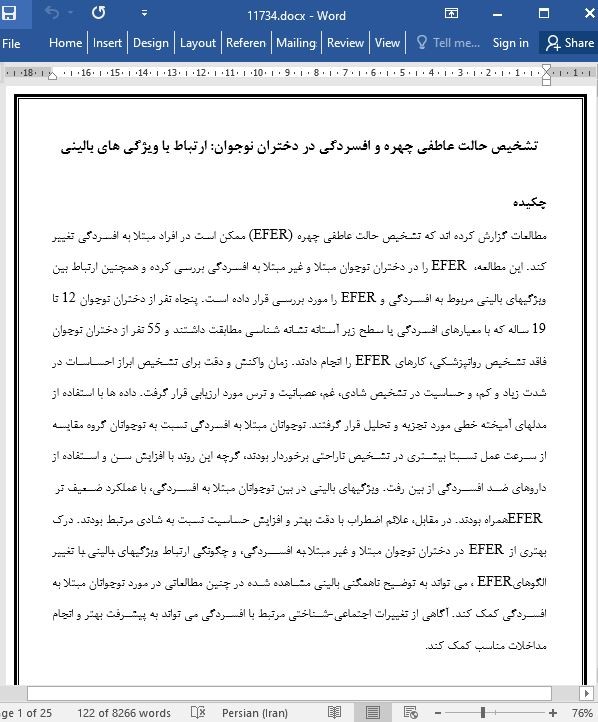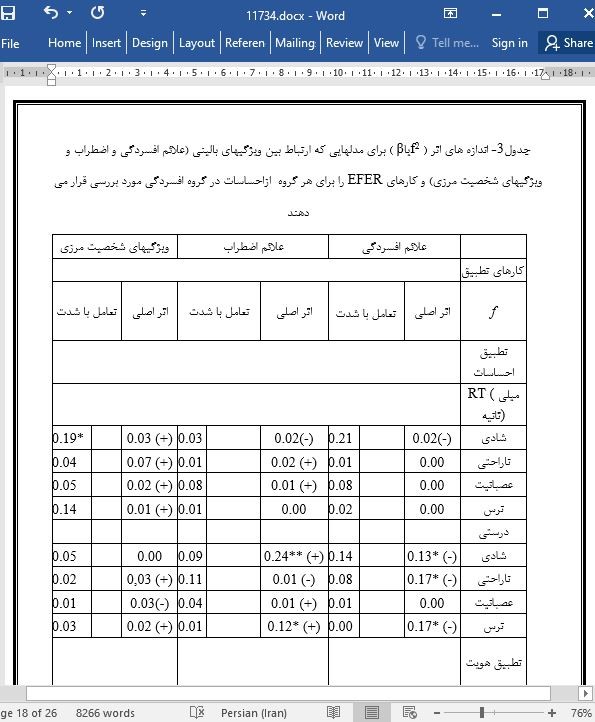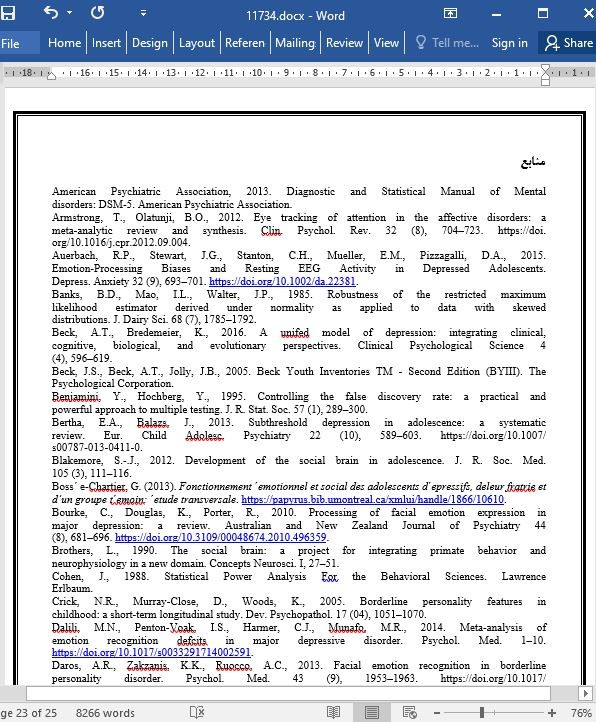
تشخیص حالت عاطفی چهره و افسردگی در دختران نوجوان
چکیده
مطالعات گزارش کرده اند که تشخیص حالت عاطفی چهره (EFER) ممکن است در افراد مبتلا به افسردگی تغییر کند. این مطالعه، EFER را در دختران نوجوان مبتلا و غیر مبتلا به افسردگی بررسی کرده و همچنین ارتباط بین ویژگیهای بالینی مربوط به افسردگی و EFER را مورد بررسی قرار داده است. پنجاه نفر از دختران نوجوان 12 تا 19 ساله که با معیارهای افسردگی یا سطح زیر آستانه نشانه شناسی مطابقت داشتند و 55 نفر از دختران نوجوان فاقد تشخیص روانپزشکی، کارهای EFER را انجام دادند. زمان واکنش و دقت برای تشخیص ابراز احساسات در شدت زیاد و کم، و حساسیت در تشخیص شادی، غم، عصبانیت و ترس مورد ارزیابی قرار گرفت. داده ها با استفاده از مدلهای آمیخته خطی مورد تجزیه و تحلیل قرار گرفتند. نوجوانان مبتلا به افسردگی نسبت به نوجوانان گروه مقایسه از سرعت عمل نسبتا بیشتری در تشخیص ناراحتی برخوردار بودند، گرچه این روند با افزایش سن و استفاده از داروهای ضد افسردگی از بین رفت. ویژگیهای بالینی در بین نوجوانان مبتلا به افسردگی، با عملکرد ضعیف تر EFER همراه بودند. در مقابل، علائم اضطراب با دقت بهتر و افزایش حساسیت نسبت به شادی مرتبط بودند. درک بهتری از EFER در دختران نوجوان مبتلا و غیر مبتلا به افسردگی، و چگونگی ارتباط ویژگیهای بالینی با تغییر الگوهای EFER، می تواند به توضیح ناهمگنی بالینی مشاهده شده در چنین مطالعاتی در مورد نوجوانان مبتلا به افسردگی کمک کند. آگاهی از تغییرات اجتماعی-شناختی مرتبط با افسردگی می تواند به پیشرفت بهتر و انجام مداخلات مناسب کمک کند.
1. مقدمه
افسردگی یکی از دلایل اصلی ناتوانی است (Ferrari و همکاران ، 2013) ، و یکی از مشکلات شایع سلامت روان است که نوجوانان در سراسر جهان به آن دچار می شوند (Lopez و همکاران ، 2006). خطر ابتلا به افسردگی به طور قابل توجهی با بلوغ افزایش می یابد (انجمن روانپزشکی آمریکا ، 2013). نوجوانی نشاندهنده یک گذار جسمی، روانی و اجتماعی بین کودکی و بزرگسالی است و یک دوره آسیب پذیر برای بوجود آمدن مشکلات سلامت روان مانند افسردگی محسوب می شود (Blakemore ، 2012 ؛ Vijayakumar و همکاران ، 2018). پس از بلوغ، افسردگی در میان زنان در مقایسه با مردان شیوع بیشتری دارد (Kuehner ، 2017 ؛ Thapar و همکاران ، 2013). برآورد شیوع اختلال افسردگی عمده در طی دوره زندگی در زنان کانادایی 15-24 ساله 12.8 درصد می باشد (آمار کانادا ، 2017)، و واریانتهای زیر آستانه تا سن 20 سالگی تا 22.2% بیان می شود (Rohde و همکاران ، 2009).
5. نتیجه گیری
در حالیکه یافته های مبتنی بر گروه قابل توجه نبودند، تجزیه و تحلیل ما با تمرکز بر نوجوانان مبتلا به افسردگی نشان داد که ویژگیهای بالینی شدت علائم افسردگی و ویژگی های شخصیت مرزی با عملکرد ضعیف تر EFER همراه هستند. با این حال، علائم اضطراب با افزایش دقت و حساسیت نسبت به شادی مرتبط بود. درک بهتر هر دو تفاوت گروهی در EFER و مطالعه دقیق تر ویژگیهای بالینی در رابطه با EFER در دختران مبتلا به افسردگی می تواند برای پزشکان سودمند باشد. آگاهی در مورد تغییر در پردازش احساسات و چگونگی ارتباط این امر با ویژگیهای بالینی مرتبط با افسردگی می تواند برای شناسایی اهداف مداخله مربوطه و ارائه درمان متناسب با نیازهای افراد مهم باشد.
Abstract
Studies have reported that emotional facial expression recognition (EFER) may be altered in individuals with depression. This study examined EFER in adolescent girls with and without depression and further examined associations between relevant clinical features of depression and EFER. Fifty adolescent girls aged 12 to 19 years old meeting criteria for depression or subthreshold levels of symptomatology and 55 adolescent girls with no psychiatric diagnosis completed EFER tasks. Reaction time and accuracy for recognising expressions at high and low intensities, and sensitivity in recognising happiness, sadness, anger and fear were assessed. Data were analysed using linear mixed models. Adolescents with depression were marginally faster than those in the comparison group to recognize sadness, although this trend disappeared once covarying for age and antidepressant use. Amongst adolescents with depression, clinical features were associated with poorer EFER performance. In contrast, anxiety symptoms were linked to better accuracy and heightened sensitivity towards happiness. A better understanding of EFER in adolescent girls with and without depression, and how clinical features might be associated with altered patterns of EFER could help to explain clinical heterogeneity observed in such studies of adolescents with depression. Knowledge of socio-cognitive alterations associated with depression will help to better develop and tailor interventions.
1. Introduction
Depression is a leading cause of disability (Ferrari et al., 2013) and a common mental health problem experienced by adolescents worldwide (Lopez et al., 2006). Risk for the onset of depression increases significantly with puberty (American Psychiatric Association, 2013). Adolescence represents a physical, psychological and social transition between childhood and adulthood and is a vulnerable period for the development of mental health problems such as depression (Blakemore, 2012; Vijayakumar et al., 2018). Following puberty, depression is more prevalent amongst women compared to men (Kuehner, 2017; Thapar et al., 2013). Prevalence of lifetime major depression is estimated at 12.8% in 15–24-year-old Canadian females (Statistics Canada, 2017), and up to 22.2% express subthreshold variants by the age of 20 years (Rohde et al., 2009).
5. Conclusion
While group-based findings were not significant, our analyses focusing on adolescents with depression indicated that clinical features of severity of depression symptoms and borderline personality features were associated with poorer EFER performance. Symptoms of anxiety were however associated with increased accuracy and sensitivity towards happiness. A better understanding of both group differences in EFER and a more nuanced study of clinical features in relation to EFER in girls with depression could prove informative for clinicians. Knowledge on alterations in emotion-processing and how this relates to pertinent clinical features of depression could be important for identifying relevant intervention targets and tailoring treatment to individual needs.
چکیده
1. مقدمه
2. روشها
2.1. شرکت کنندگان
2.2 روند کار
2.3 تجزیه و تحلیل ها
3 نتایج
3.2 آمار توصیفی
3.3 اختلافات گروهی
3.4 ویژگیهای بالینی و EFER در گروه افسردگی
4 بحث
4.1 تفاوتهای گروهی
4.2 ویژگیهای بالینی و EFER در گروه افسردگی
4.3 نقاط قوت و محدودیتها
5 نتیجه گیری
منابع
Abstract
1. Introduction
2. Methods
2.1. Participants
2.2. Procedures
2.3. Analyses
3. Results
3.1. Descriptive information
3.2. Group differences
3.3. Clinical features and EFER within the depression group
4. Discussion
4.1. Group differences
4.2. Clinical features and EFER within the depression group
4.3. Strengths and limitations
5. Conclusion
References
- اصل مقاله انگلیسی با فرمت ورد (word) با قابلیت ویرایش
- ترجمه فارسی مقاله با فرمت ورد (word) با قابلیت ویرایش، بدون آرم سایت ای ترجمه
- ترجمه فارسی مقاله با فرمت pdf، بدون آرم سایت ای ترجمه



